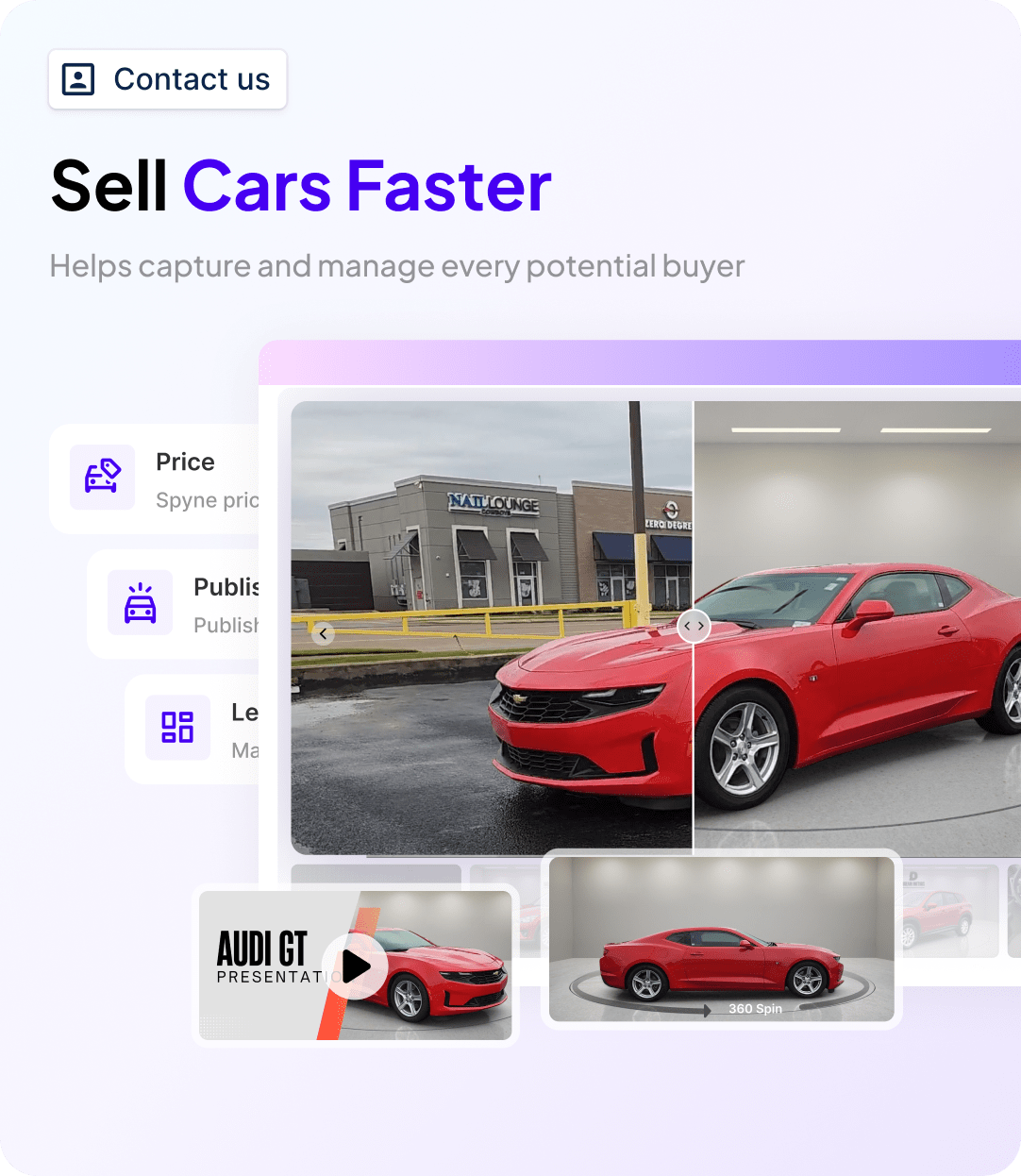Car alignment is an important part of your vehicle’s overall health and performance. Yet, it’s one of the most overlooked services in regular car maintenance.Misalignment can sneak up on you. You might start noticing uneven tire wear, a slight pull to one side, or a steering wheel that feels off-center. These may seem minor at first, but over time, they can affect your fuel efficiency, tire life, and even your safety on the road.
In this blog, we’ll discuss everything you need to know about car alignment, including how it works and why it matters, how often you should get it checked and the role of emerging technologies like AI in spotting issues early. We’ll also cover the different types of alignment, wheel alignment costs, and how tools like Spyne’s automotive solutions are helping service centers offer better, smarter after-sales care.If you’re a car owner, a technician, or someone who wants to avoid unnecessary repair bills, this guide will help you understand how to keep your car rolling straight.
What is Car Alignment?
Car alignment, also known as wheel alignment, refers to the adjustment of your vehicle’s suspension system which is the system that connects your car to its wheels. Contrary to what some may think, alignment isn’t about adjusting the wheels or tires themselves. Instead, it’s about fine-tuning the angles of the tires so they make proper contact with the road.
There are three main angles involved in alignment:
- Camber: This is the inward or outward angle of the tire when viewed from the front of the vehicle. Too much inward or outward tilt means improper camber, which can lead to uneven tire wear.
- Toe: Toe wheel alignment deals with the angle at which the tires turn inward or outward when viewed from above. If you are looking down on your car and the wheels point toward each other, that’s toe-in. If they point away from each other, that’s toe-out. Both situations affect tire wear and vehicle handling.
- Caster: This angle helps balance steering, stability, and cornering. Caster refers to the angle of the steering axis when viewed from the side of the vehicle.
Proper automotive alignment helps in making sure that all these angles are perfectly set according to your car manufacturer’s specifications. This helps extend the life of your tires, improves vehicle performance, and improves overall driving safety.
Why is Alignment Important?
Car alignment is like body posture. If you walk with poor posture, it puts stress on muscles and joints, and over time, that leads to discomfort and damage. The same is true with your car. A poorly aligned vehicle puts unnecessary strain on the suspension and tires, which may result in:
- Uneven or rapid tire wear: Misaligned wheels don’t make even contact with the road, causing certain parts of the tire to wear out faster. This means you’ll be replacing your tires sooner than expected.
- Steering problems or pulling to one side: Does it feel like your car wants to drift to the left or right even though you’re steering straight? That’s a classic sign of poor alignment and it can make driving more tiring and less safe.
- Reduced fuel efficiency: When your wheels aren’t aligned properly, your car has to work harder to move forward. That extra resistance burns more fuel, costing you more at the pump.
- Poor handling and increased risk of accidents: Misalignment affects how responsive and stable your car feels, especially when turning or braking. That kind of unpredictability can be dangerous in sudden or emergency situations.
- Suspension wear and tear: Constant strain from poor alignment can lead to premature wear on your car’s suspension components, which can be expensive to repair if left unchecked.
When your wheels aren’t aligned properly, your car works harder than it needs to. That’s why front wheel alignment and auto wheel alignment are standard maintenance items recommended by every car manufacturer.
It’s also a matter of wheel alignment price. The average auto wheel alignment cost is far lower than the cost of replacing four prematurely worn-out tires or fixing suspension damage. And with regular alignment checks, you can often catch minor issues before they become major headaches.
Signs Your Car Needs an Alignment
Not sure whether it’s time for an alignment? Here are the most common red flags to watch out for:
- Your car pulls to one side: If your steering wheel feels like it has a mind of its own, pulling left or right, it’s a sign of misalignment.
- Uneven tire wear: If the inside or outside of your tire tread is wearing faster than the middle, alignment is likely off.
- Steering wheel is crooked: When you’re driving straight but your steering wheel isn’t centered, something’s not right.
- Loose or shaky steering: This may feel like poor road grip or a lack of control when turning.
- Vibration while driving: Especially at higher speeds, vibration in the steering wheel can be due to alignment or balancing issues.
If you experience any of these symptoms, it’s worth scheduling a car wheel alignment check. Many garages now offer wheel alignment deals or free inspections with tire service, so you don’t have to break the bank to stay safe on the road.
Types of Car Alignment
Not all cars are the same, and neither are alignments. Depending on your vehicle’s make, model, and drivetrain, you’ll need one of the following alignment types:
1. Front End Alignment
This is the most basic type, typically used on older or non-four-wheel drive vehicles. Front end alignment adjusts the angles of the front two wheels only.
2. Four-Wheel Alignment
As the name suggests, this type adjusts all four wheels and is commonly used for newer vehicles with independent rear suspension. It ensures both the front and rear axles are aligned correctly.
3. Thrust Alignment
This type is a mix of front-end and four-wheel alignments. It ensures that all four wheels are “squared” with each other, and it’s typically used on vehicles with solid rear axles.
Choosing the right type of alignment on vehicle depends on the car’s suspension system. A qualified technician will determine which type is appropriate for your car.
How Often Should You Get Your Car Aligned?
There’s no one-size-fits-all answer, but a general rule is to get a car alignment check every 6,000 to 10,000 miles or at least once a year. But, you may need alignment sooner if:
- You’ve hit a pothole or curb
- You’ve been in a minor accident
- You’ve recently had suspension or steering repairs
- You notice any of the signs mentioned earlier
It’s also a good idea to include alignment checks as part of your routine servicing, especially during tire rotations. Some dealerships include it in regular service packages or offer wheel alignment price reductions when bundled with other services.
If you’re someone who uses car merchandising tools or runs a fleet, maintaining regular alignment on vehicles ensures they’re always in top condition, not only for performance but also for resale value.
How AI Can Help Detect Alignment Issues
Thanks to advances in automotive tech, AI-powered diagnostics are now stepping in to make alignment checks more accurate, efficient, and data-driven.
AI tools can:
- Analyze car images or car videos to detect abnormal tire angles
- Cross-reference real-time driving data like steering behavior, tire wear patterns, and suspension performance
- Use car 360 spin imagery to spot uneven wheel positions in showrooms or digital platforms
These systems are particularly useful in modern service centers and for dealerships that want to streamline after-sales service. Using AI for car wheel tracking not only speeds up the diagnostic process but also reduces human error, so that your alignment is spot-on every time.
Car Alignment vs. Car Balancing – What’s the Difference?
It’s easy to confuse alignment with balancing, but they’re actually two very different services:
| Aspect | Car Alignment | Car Balancing |
| What it fixes | Suspension angles, wheel positioning | Tire and wheel weight distribution |
| Symptoms | Pulling, uneven wear, off-center steering | Vibration, noise, bouncing |
| Tools used | Alignment machine, sensors, and angle adjustments | Spin balancer, weights for the wheel |
| Cost range | Car alignment cost: $50–$150 | Balancing cost: $15–$50 per tire |
If your car has both alignment and balancing issues, addressing them together gives you a smoother, safer ride.
Why Do Both Matter?
Car alignment is setting the direction of your wheels, while balancing ensures they spin smoothly. Even if your wheels are perfectly aligned, if they’re not balanced, your ride can still feel shaky or noisy. Similarly, a well-balanced wheel with poor alignment will wear out quickly and handle poorly.
Together, alignment and balancing:
- Improve your car’s fuel efficiency
- Reduce tire wear
- Enhance driving comfort and safety
- Prevent long-term suspension damage
If your car is vibrating and pulling to one side, it likely needs both services. Check for car alignment cost and balancing cost. Getting them done together ensures your car feels stable, smooth, and safe, especially during high-speed driving or long trips.
How Spyne’s Automotive Tools Support After-Sales & Servicing
Spyne, known for its innovation in car photography and digital tools, is now stepping into the world of automotive after-sales with a suite of smart services aimed at improving the post-purchase experience.
Spyne technology can be used for:
- AI-based damage detection: Identifying misalignments or worn parts through high-resolution car images.
- Car wrap simulation: Helping customers visualize customizations without touching the car.
- Digital vehicle presentations: Including car animation video walkthroughs and car 360 spin tools for both inspection and merchandising.
Service centers can integrate Spyne’s visual intelligence platform to provide real-time insights into vehicle health, including possible alignment issues. This bridges the gap between visual data and servicing needs. It also reduces vehicle inspection times and improves transparency for customers without guessing games.
Spyne’s tools support better maintenance decisions and more informed service recommendations. Spyne is about using smart tech to do it faster and better.
Conclusion
Keeping your car aligned isn’t another maintenance checkbox. It is in fact an important part of ensuring safety, comfort, and cost-efficiency. It results in smoother handling, longer tire life and better fuel economy. The benefits of car wheel alignment are hard to ignore.
Now, with tools like AI diagnostics and platforms like Spyne offering deep insights through car visuals and tech-enhanced servicing, maintaining alignment on a car has never been more precise or convenient.
Driving your daily commute, managing a fleet, or running a service center? You can now make automotive alignment a regular part of your routine. Your tires, your wallet, and your peace of mind will thank you.













